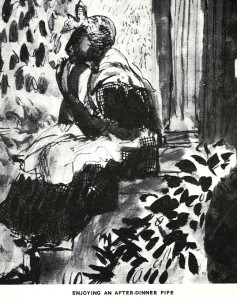Jackson native Lehman Engel (1910-82) was a composer and conductor of Broadway musicals, television and film. Engel worked as musical director for the St. Louis Municipal Opera for a number of years before moving to New York to conduct on Broadway. He won 6 Tony Awards, and was nominated for 4 more. Among other works, Engel wrote The American Musical Theatre: A Consideration, the first book to discuss in detail the writing of a Broadway musical, the elements that went into it, and the art of adapting plays into musicals. In his autobiography, This Bright Day, Engel provides an endearing profile of his friendship with Eudora Welty.
It’s strange how people in a small town know each other, speak in passing and not really know one another at all. Although I had met Eudora Welty in Jackson before either of us went away to school, it was not until several years later in New York, when a group of Jacksonians were there each simultaneously pursuing various schoolings, that we had first real contacts. Eudora was at Columbia along with Dolly Wells and Frank Lyell, who had first introduced me to Eudora in the Livingstone Park Lake. I was at Julliard. We changed to meet here and there. I think it was at Norma and Herschell Brickell’s (also from Jackson) where all of us, including Nash Burger, whose father used to play cards with my father, often went.
Each summer all of us went home to swelter, and there the threads grew stronger. There were about five such summers before I began staying on in New York, with work to occupy and to pay me. But at home, Frank, Eudora, Hubert Creekmore, and I used to meet at Eudora’s, and we formed the Night-Blooming Cereus Club, the total membership of which sat up to see the glorious white flower with the yellow feathery center bloom. The morning after, it looked like a swan with a broken neck. Those summers are jumbled together in my memory. During on of them Eudora did some letter-writing for me. Perhaps it was at another time that she took many snapshots. Several of them are among the best any photographer ever took of me. I have one of Eudora, we really invented “camp”, sitting in a tree, a Spanish shawl around her shoulders and on her face an uncharacteristic expression of world-be disdain.
With the passing of time, many things happened to us separately, and we seized every opportunity to communicate and to be together. On my visits to see my family perhaps twice a year—and more often in my parents’ failing days—Eudora was, as she is today, always available whenever it is possible for me to get away from family and family friends. To insure our being together to talk without interruption, she usually picks me up in her car—never a fancy one—and takes me for a ride just anywhere away from everybody else. At her house or mine while my mother was still alive, or at any of my cousins’, Eudora always enjoyed her bourbon and I my scotch.
She has endured a great deal. Her father died many years ago, but her mother lingered in poor health for some years. When finally it became necessary for Eudora to put her in a nursing home in Yazoo City, more than an hour’s drive from Jackson, Eudora drove to see her nearly every day. During those days she developed the habit of starting her work at 5 a.m. so tht she could spend several hours of writing without interruption. She still retains that habit. Very shortly before her mother died, Eudora’s two brothers—both married and each living in his own house—died within days of each other. I have seldom heard her refer to any of this, and what suffering she experienced she kept as her very own.
She is selfless, simple, timid, unworldly, and dedicated to her work. She has had every possible honor and success heaped on her, but nothing has ever changed her lifestyle or her nature. She lives in Jackson—the only place where she feels comfortable—travels when it is necessary only on trains (if possible), and speaks so quietly as to be often in audible. She lives in her parents’ house, which is very nice and devoid of any fanciness. It has two stories made of dark-red-to-purple bricks, and Eudora lives as she prefers—alone. The front yard has large pine trees and the house is surrounded by japonicas (camellias) of all kinds and colors. Behind the house there is a lovely garden containing more camellias and gardenias. The garden is no longer as well manicured as it once was, but I imagine Eudora prefers it that way. Now devoid of family responsibilities, she works consistently and hard. As she prefers never to discuss her work-in-progress, I seldom ask her what she is doing.
If I have given any notion that, like Emily Dickinson, Eudora is a recluse, let me assure you that she is not. She has many old friends, all of whom respect her privacy, and everyone in Jackson is deeply proud of her distinguished achievements.
LEFT: I snapped this picture of Eudora Welty with her camera. Frank Lyell was the Señor; Eudora, the unwitting inventor of camp, was herself above it all. RIGHT: Taken on a summer vacation in Jackson by Eudora Welty. I was about twenty.












